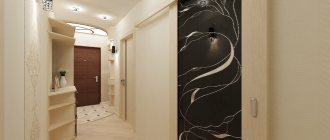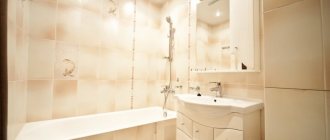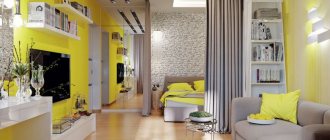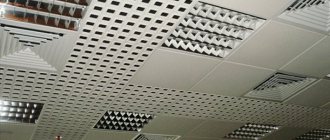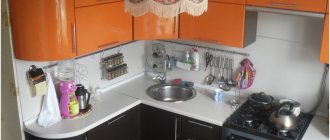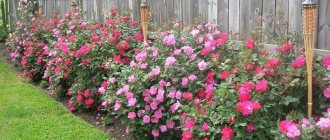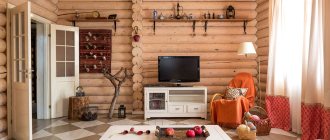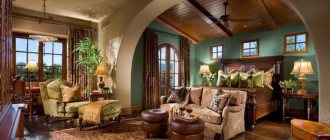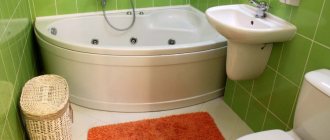How do apartment owners in Russia decorate the hallway and corridor? As a rule, these areas have small, if not tiny, areas. Since the hallway almost immediately continues with a corridor, people logically reason that the same finishing is required. And they choose the most practical types of wallpaper - washable, vinyl. That is, those that are not afraid of dirt and random mechanical impacts. However, this approach is fundamentally wrong.
From the perspective of an experienced designer, there are several focal points. It is on them that the eye falls first. Such areas require attention and careful finishing. The remaining walls can be left as background walls so as not to overload the small space.
How to make renovations in the hallway and corridor at the highest level, while saving money? What nuances should you pay attention to when finishing? We'll tell you!
Types of wallpaper, their advantages and disadvantages
Wallpaper is a finishing material for interior wall and ceiling cladding of residential premises. The canvas differs in width - from 0.53 to 1.06 m, and in length from 10 to 25 m. Wallpaper for the hallway and corridor performs the following functions:
- protective - closing pores and small cracks on the wall;
- decorative - giving an aesthetic appearance to the hallway and corridor;
- sound-absorbing - for this purpose wallpaper on a fleecy basis is used;
- lighting adjustments - light shades of a roll product add light and space, dark wallpaper, on the contrary, mutes and reduces the space of the room.
Wallpapers are classified according to several parameters.
Moisture resistance of the coating:
- Regular wallpaper is not resistant to moisture. Used in rooms with minimal humidity.
- Moisture-resistant products - used in moderate humidity. Short-term wiping with a low concentration of detergents is allowed.
Washable wallpaper tolerates various types of humidity well, including wet cleaning with cleaning agents.
Roll density:
- Smooth, smooth wallpaper.
- Relief and roughness of the product.
- A roll with embossed patterns using the compressed method.
Weight:
- Light wallpaper - 110 g/sq. m.
- Average wallpaper - from 110 to 140 g/m2. m.
- Heavy wallpaper - more than 140 g/m2. m.
Connection method:
- Fitting when connecting a pattern when gluing.
- Lack of fit - wallpaper is glued end to end.
The expiration date of the roll is indicated on the packaging. The appearance and safety of the papered walls depend on the climate in which the building is erected. Negative effects on wallpaper have: temperature changes, high humidity, direct sunlight.
To choose the right wallpaper for the hallway and corridor, you first need to familiarize yourself with the wide range. There are wallpapers: paper, vinyl, non-woven and textile. Each type is unique in its own way and has a number of advantages and disadvantages.
Briefly about the main thing: how to choose wallpaper for the hallway
So, when choosing wallpaper for the hallway, you can be guided by different criteria.
- If you value environmentally friendly solutions and naturalness, evaluate the design projects of corridors with wallpaper made of paper, cork, bamboo and choose your type of canvas.
- Paper canvases also benefit in comparison with any other in price.
- If service life and ease of working with materials are more important to you than price, compare the advantages of vinyl, non-woven and liquid wallpaper.
When choosing a wallpaper design, pay attention to colors and prints that will visually transform the layout. For example, if the hallway is small, narrow and dark, pay attention to the following wallpaper designs:
- plain, pastel colors
- simple discreet print
- vertical lines
- paintings that add depth to a space
- or any universal geometric pattern that will match any piece of furniture.
Use ready-made elegant ideas that will allow you to decorate even a simple corridor in a chic and tasteful way.
Paper wallpaper for the hallway
Structurality is the main characteristic of paper wallpaper. A roll made in one layer is called simplex, and in two layers it is called duplex. The latter have a protective coating from moisture and light. Photo wallpaper is a washable product, different from ordinary rolls with a small print and a large, solid pattern. Before gluing to the wall, the photopanel is cut into 4 or 6 pieces.
Pros:
- low cost;
- environmental friendliness;
- variety of designs;
- masking small uneven surfaces;
- ease of gluing.
The disadvantages include fear of moisture, sunburn, and low noise suppression.
The maximum service life of paper wallpaper is up to five years with careful care.
Vinyl wallpaper for the hallway
A polyvinyl chloride layer up to 1 mm thick is applied to the non-woven or paper base of the wallpaper. This gives the rolled material strength and resistance to sunlight and moisture.
Vinyl wallpaper amazes with a wide selection of colors, prints, and textures. Some of the most popular types of vinyl wallpaper are:
- foam wallpaper product with an original design;
- silk-screen printing - the use of silk threads;
- Embossed vinyl is made using the cold pressing method;
- hot stamping - the relief of vinyl wallpaper is achieved when exposed to high temperatures.
Advantages:
- immunity to direct sunlight;
- moisture resistance;
- average price;
- high strength.
Disadvantage: the need to install a ventilation system due to air tightness.
Due to the heavy weight of vinyl products, it is necessary to purchase special glue for gluing.
Which coatings are easy to apply?
If you plan to do renovations in the hallway yourself, without involving specialists, then the main criterion for choosing wallpaper for the hallway will be the ease of gluing it. It is believed that self-adhesive wallpaper is ideal for beginners, but you also need to be careful with it. Paper wallpaper can easily tear when wet, and it is difficult to correct it directly on the wall.
Self-adhesive wallpaper is suitable for beginners
It is very good and convenient to glue vinyl wallpaper and non-woven wallpaper. When wet, they do not tear; they can be straightened directly on the walls without fear that they will come apart. If the canvas is glued incorrectly, it can easily be torn off. In addition, such wallpapers can be very wide, which allows you to quickly cover a room, especially if it is small, as hallways usually are.
Vinyl wallpaper can be corrected directly on the wall
Non-woven wallpaper for the hallway
The basis of the wallpaper is a non-woven fiber consisting of cellulose fibers. The main property of the material is air and moisture permeability. The elasticity of thin non-woven fabric allows the material to be used on uneven walls. Wallpaper of medium and high density does not stretch, so the surfaces are first leveled.
Non-woven wallpaper is divided into the usual type and the “paintable” form. The texture of wallpaper varies from smooth to textured, embossed and even 3D patterns.
Advantages of finishing non-woven material:
- no increase in volume when interacting with water or glue, retention of shape after drying;
- masking small irregularities;
- strength during the formation of small cracks on walls in new buildings;
- decrease in thermal conductivity;
- vapor permeability, i.e. “wallpaper breathes.”
The disadvantages of non-woven wallpaper are the accumulation of dirt and dust due to the texture, as well as the high price category.
Wallpaper selection
Before deciding which wallpaper to choose for the hallway, you need to know some aspects:
- Choosing warmer wallpaper tones helps to visually reduce the space of the corridor. For expansion, it is recommended to pay attention to cool shades.
- The hallway is an ideal place to collect dust from shoes and clothes. Therefore, it is practically necessary to focus on the choice of cleaning wallpaper.
- A combination of shades (warm and cold tones) will create at the same time a cozy and spacious corridor.
Under such canvases even decent cracks will not be visible.
Vinyl
Vinyl coating (polyvinyl chloride or PVC) creates a very dense and durable film on the surface. Such wallpaper is also called detergent wallpaper because of its ability to withstand cleaning with a cloth and detergents.
The basis for vinyl wallpaper can be paper or non-woven fabric. It is easier to glue non-woven ones. You simply apply glue to the surface of the wall and apply the canvas cut to size. This wallpaper for a corridor can also be glued to slightly uneven walls.
One of the types of vinyl wallpaper with imitation brickwork
Paper-based wallpaper must first be coated with glue and folded so that the coated surface is on the inside. At this time, you need to smear the wall, and then glue the slightly softened canvas. This is where the danger lies: soaked paper can easily be stretched, which will cause distortions, folds and other troubles to appear on the wall. So it’s easier to work with a non-woven base, especially since they better hide surface imperfections and there is no need to carefully level the walls. However, there is one “but” - are they more expensive than paper-based ones? and the difference is approximately 40%.
In addition to different bases, vinyl wallpapers also differ in the method of application.
- Dense or smooth. The film is durable, high density, most often smooth, sometimes with a slightly pronounced texture. Often imitates ceramic tiles, stone and other similar materials. Due to its high density, it is not afraid of high humidity, you can even wash it with a brush. This hallway wallpaper is a great choice, but only if your walls are relatively flat.
Smooth vinyl wallpaper
- Foamed vinyl. The structure is porous, which allows the walls to “breathe”. This is the only breathable type of vinyl wallpaper. But porosity also has a drawback: it is not recommended to wet them too much. You can clean it, but with a damp cloth. What’s also good is that due to the thick film, even significant irregularities are well masked. Foamed vinyl wallpaper imitating leather
- Hard vinyl. A very dense and hard film, the surface often imitates various natural finishing materials: stone, brick, textiles, textured plaster, etc. The imitation is of very high quality, the color palette is wide. They are characterized by increased strength and wear resistance. There are options for painting. Heavy vinyl
- Hot stamping is also called “silk-screen printing”. The surface has a characteristic soft shine. This wallpaper is thin, which increases the quality requirements for wall preparation.
Silk-screen printing is easy to recognize by its characteristic shine
Any type of vinyl wallpaper will work well in a hallway. They are highly durable, resistant to fading, and wash well. The average service life is about 7-10 years. Vanilla wallpaper for the corridor is good for everyone, except that some of them are difficult to join, but this can be combated by gluing a special tape at the joint.
Glass wallpaper
This type of wallpaper can be painted. The canvas has a certain relief, most often medium-sized. The relief of the pattern allows you to hide flaws in the processing of the wall. You can paint from 3 to 8 times - depending on the type (and price) of the canvas. Glass wallpaper allows air to pass through well, is vapor permeable, and does not emit harmful substances. Overall, a good choice if you're happy with painted walls.
One of the reliefs on the wall
Liquid formulations
Is it a mixture of cellulose, cotton, and sometimes chemicals? fibers with coloring pigment and adhesive composition. There are two forms of release: ready for use in bottles or in bags for dilution with water. Apply with spatulas to the prepared surface. It should not be ideally even: the layer thickness can be up to 5 mm, but too much consumption is not financially profitable.
The composition is applied with a spatula. Some craftsmen use plastic ones made of plexiglass, some use ordinary ones made of stainless steel, and some even work with “smoothers”. There are many techniques, choose the one that is most convenient for you.
Based on the surface characteristics, liquid wallpaper for the corridor is a good option. Since the compositions are painted to the full depth, scratches are not visible, many of them can be washed not just with a rag, but also with a brush. But before purchasing, check all the performance characteristics and features. They may have significant differences.
Natural
There is also a group of wallpapers that use natural materials in their production. Cork chips or bamboo are glued onto the base, most often fabric or non-woven fabric. They look great - the surface is natural. However, they have their own characteristics. The cork comes off, which can be a problem in families with children. Some types of bamboo sheets must be varnished, and they must also be glued with a special glue. Although it must be said that bamboo wallpaper for a corridor in an oriental style is a godsend: they look magical.
Bamboo wallpaper for a corridor in an oriental style is an excellent choice
If done correctly, cork ones look no worse. An example can be seen in the photo. At the top there is wallpaper made of bamboo, at the bottom - from cork.
Cork wallpaper: the main thing is to combine it correctly
Textile wallpaper for the hallway
The basis for textile wallpaper is paper or non-woven fabric, onto which fabric or woven raw materials are applied, for example, linen, cotton, jute. The fabric may contain three-dimensional relief patterns. Due to its breathability, wallpaper is suitable for decorating a bedroom or children's room.
Textile wallpaper has disadvantages:
- overpriced;
- fear of moisture, the appearance of marks even after small drops of water;
- frequent need to vacuum the walls due to the accumulation of dust and dirt;
- difficulty in gluing.
Textile finishing material also has its advantages: a unique design, natural materials, increased service life, and the creation of a presentable appearance.
Glass wallpaper
Wallpaper made of fiberglass material is a special finishing type for painting. Advantages of fiberglass:
- moisture resistance;
- endurance of repeated staining up to 20 times;
- service time of at least 20 years;
- passage of steam and air.
This “long-lasting” material has several disadvantages. For example, a small assortment, a strict “office” look, tiny glass chips getting into the air and the use of special clothing when gluing.
What material is wallpaper made from?
For the production of wallpaper, not only paper is used, but also other materials, for example, textiles or vinyl. It is important to remember that the quality of finishing wallpaper depends on the properties of the material used for its production.
Wallpaper made from low-quality materials or unsuitable for the front room can reduce the space, shine unnaturally, or simply not fit with the overall design of the living space. To understand which wallpaper to choose for the hallway, you need to familiarize yourself with the existing varieties.
Liquid wallpaper
The material differs from ordinary wallpaper in shape - it is a plaster mixture consisting of glue, textile and cellulose fibers, and mineral components. Wallpaper can be applied to an uneven wall using a special spatula.
Advantages of liquid wallpaper:
- naturalness of the composition;
- increased repairability - any recess can be restored;
- moisture resistance;
- high sound insulation;
- antistatic;
- application on surfaces of various shapes;
- masking wall unevenness.
The disadvantages include a very high cost and a small number of colors.
Stylistic decisions
The main role in shaping the image of the hallway and corridor is played by wallpaper. Despite the fact that the choice of colors, patterns and structure of the finishing material is not limited, important factors should be taken into account: layout, volume of the room, degree of illumination.
Wallpaper for the hallway in a classic style
To create a classic style, you need to use wallpaper in muted shades. The colors are subdued. Preference is given to natural materials. To avoid “boring” in the hallway interior, it is better to choose wallpaper in pastel shades: blue, light green, pink, peach. Drawings can be in the form of monograms, stripes, or floral patterns. The main rule of the classics is the absence of clumsiness and strict geometry. Textile or non-woven wallpaper can serve as a classic base.
Wallpaper for the hallway in a modern style
Modern style is characterized by functionality, the absence of unnecessary decorative elements, and a smooth transition of lines. The wallpaper print for the hallway and corridor is geometry, realistic photo wallpaper, one tone.
Wallpaper for the hallway in Provence style
The Provençal style will help you get into a cozy rustic hallway from the French countryside for a moment. To do this, you should choose wallpaper with a warm, not bright color scheme, decorated as a print with small flowers or a cage.
Wallpaper for the hallway in Scandinavian style
Scandinavian style is minimalism, light shades that together create a cozy atmosphere. Wallpaper for the hallway and corridor should be cold in color, but not dark and gloomy, the patterns should be Scandinavian patterns.
Photo wallpaper
Modern technologies make it possible to transfer any image to paper. With the advent of high-quality large-format photo printing, it became possible not to assemble an image from pieces, but to glue it together as a continuous sheet. This looks much better. Photo wallpaper is also used in the hallway.
Photo wallpaper for the corridor: city landscapes are popular, but from different times
But, with such a design of the walls, one condition must be observed: everything else is very calm, almost monochrome. The main focus is photography. Otherwise you will end up with something incomprehensible.
Flowers, plants, nature - the second popular motif
Wallpaper color for the hallway, which one to choose
If it is quite easy to decide on the type of wallpaper based on environmental parameters and budget, then a small dilemma may arise with color. Let's look at the main variations:
White wallpaper
White wallpaper in the hallway and hallway allows you to create the effect of spaciousness, cleanliness and comfort. The negative side of snow-white splendor is its susceptibility to pollution and dust.
Black wallpaper
Wallpaper for the hallway and corridor in black is best suited for large rooms. A small area will involuntarily create a “closet” effect.
Blue wallpaper
Giving freshness and cleanliness are the benefits of blue wallpaper for the hallway. This color is suitable for small areas.
Gray wallpaper
It would be wrong to call gray shades boring, because this color will be the best background for implementing bold design projects. The versatility of gray wallpaper for the hallway lies in its ideal combination with other colors.
Beige wallpaper
Warmth and comfort emanate from the beige wallpaper for the hallway. It is best to combine beige walls with brown, white or gray elements.
Corridor
A person spends quite a long time in the hallway, regardless of its size. He needs to get dressed or undress, look in the mirror, straighten his clothes and hair. But the corridor is a special room in the house. They pass it without stopping. There is no need to stop, look around at the situation, or do something. That is why experts say: there is no point in decorating most of the corridor with colorful, expensive wallpaper. This is just throwing money away.
Choosing wallpaper for a small hallway
For the most part, owners of houses or apartments have small hallways. To avoid focusing on a small space, you need to choose wallpaper in light shades - this will visually increase the illumination and expand the small hallway. Wallpaper for a small hallway should be matte, without a complex pattern or relief. If you don’t have the strength to fight the desire to add zest to the interior, then you should limit yourself to using relief fabrics on only one wall, in which case the remaining surfaces should be plain.
